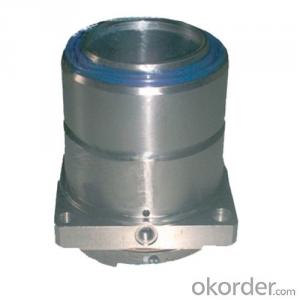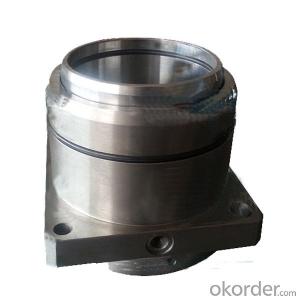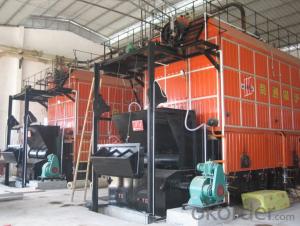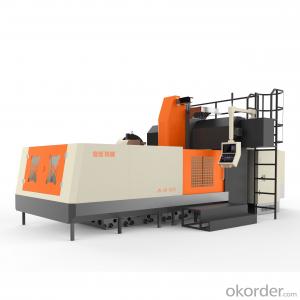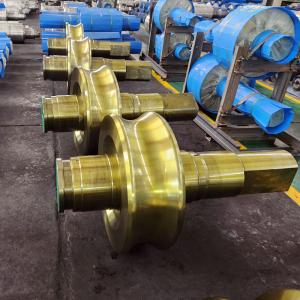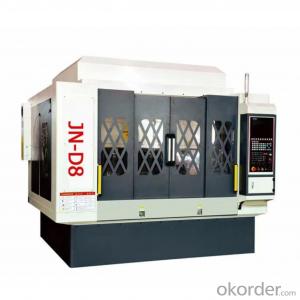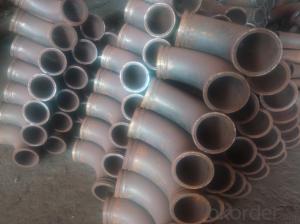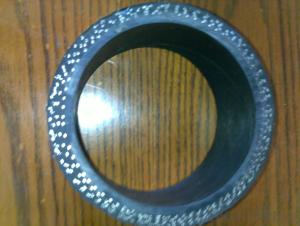Concrete Pumps Spare Parts Complete Upper Housing Q80
- Loading Port:
- Tianjin
- Payment Terms:
- TT OR LC
- Min Order Qty:
- 1 pc
- Supply Capability:
- 1000 pc/month
OKorder Service Pledge
OKorder Financial Service
You Might Also Like
Product Description:
The Concrete Pumps Spare Parts Complete Upper Housing Q80 normally made by special steel materials, according to customer’s requests, and also package in plywood box and put into container.
Scope of Application of the pipes
The Concrete Pumps Spare Parts Complete Upper Housing Q80 is a concrete pumps parts for combined use with other concrete parts in for concrete pumps and truck pumps. It can be widely used in the construction of various types of concrete structures like industrial and civil buildings, bridges, roads, and other types of infrastructure.
This pipes can only be used in concrete construction operations, but not in any other operations, like dragging, moving, or hoisting heavy articles or personnel. The parts is also not allowed to be used in any location where any combustible or explosive material exists or a cave-in may occur.
Product Advantages:
OKorder's Concrete Pumps Spare Parts Complete Upper Housing Q80 Channels are durable, strong, and safety.
Main Product Features:
· Premium quality
· Prompt delivery & seaworthy packing (5-10 days)
Reliable performance
Easy to weld
High safety.
· Professional Service
· Competitive pricing
Measuring of wall thickness from the outside
Low purchase cost
Specifications:
CNBM No. | 2080016 |
Original No. | 401783 |
Description | Complete Upper Housing Q80 |
Remark |
FAQ:
Q1: How long about delivery time Concrete Pumps Spare Parts Complete Upper Housing Q80 ?
A1: Normally we keep the raw materials for old customers and sometime we also keep stock products to make sure delivery time in any emergency cases.
Q2: How do we guarantee the quality of our Concrete Pumps Spare Parts Complete Upper Housing Q80 ?
A2: We have established an advanced quality management system which conducts strict quality tests at every step, from raw materials to the final product. At the same time, we provide extensive follow-up service assurances as required.
Q3: How soon can we receive the product after purchase?
A3: Within three days of placing an order, we will book the vessel for goods. The specific shipping date is dependent upon international and government factors, but is typically 7 to 30 workdays.
Q4: If we can produce some Slewing Lever according to customers request?
A4: Yes, we can produce Complete Upper Housing Q80 according to the difference country situations to make it suitable to the market and customers. We have very professional technical team to make the design.
Q5: How to make a quick resolution for after service?
A5: OKorder and our manufacture both have overseas branches all-around of world.
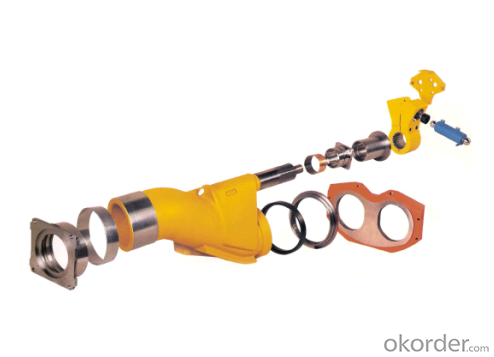

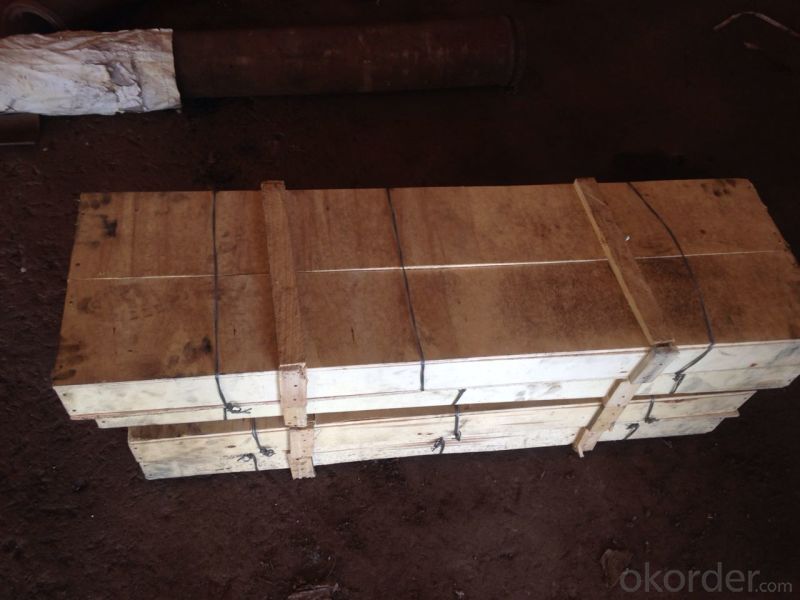
- Q:What are the potential risks of using non-standard or modified hydraulic components in concrete pump spare parts?
- There are several potential risks associated with using non-standard or modified hydraulic components in concrete pump spare parts. Firstly, these components may not have undergone the same rigorous testing and quality control as the original equipment manufacturer (OEM) parts. As a result, their performance and durability may be compromised, which can lead to potential failures or malfunctions. This, in turn, can cause accidents, injuries, or damage to the equipment or surrounding structures. Secondly, the use of non-standard or modified components may void the warranty of the concrete pump and its spare parts. Typically, manufacturers offer warranties to ensure the reliability and safety of their products. However, by using non-standard components, the warranty may become null and void. Consequently, the user will be responsible for any repairs or replacements needed due to issues arising from these non-standard parts. Another risk is the potential compatibility issues that may arise when using non-standard or modified components. Hydraulic systems rely on precise engineering and compatibility between various components to function optimally. Non-standard or modified parts may not fit properly or may have different specifications, resulting in leaks, pressure imbalances, or reduced overall performance. Furthermore, the use of non-standard or modified components can impact the overall efficiency and productivity of the concrete pump. OEM parts are specifically designed to work seamlessly with the rest of the system, ensuring smooth operation and maximum output. However, by using non-standard parts, the performance of the pump may be compromised, leading to increased downtime, decreased productivity, and higher maintenance costs. Lastly, the use of non-standard or modified components can also have legal and regulatory implications. Certain jurisdictions may have regulations or standards in place that require the use of OEM or certified parts for specific equipment, including concrete pumps. Failure to comply with these regulations can result in fines, penalties, or legal liabilities in the event of accidents or failures. In conclusion, the potential risks associated with using non-standard or modified hydraulic components in concrete pump spare parts include compromised performance and durability, warranty voidance, compatibility issues, reduced efficiency, and legal and regulatory implications. It is always advisable to use OEM or certified spare parts to ensure the safety, reliability, and optimal performance of the equipment.
- Q:Are there any specific maintenance procedures for concrete pump spare parts?
- Yes, there are specific maintenance procedures for concrete pump spare parts. It is important to regularly inspect and clean the spare parts to remove any debris or blockages that may affect their performance. Additionally, lubrication should be applied to moving components to ensure smooth operation. Regular maintenance and timely replacement of worn-out or damaged parts is crucial to maximize the lifespan and efficiency of concrete pump spare parts.
- Q:How can a faulty filter affect the pumping process?
- A faulty filter can significantly affect the pumping process in several ways. Firstly, a faulty filter may become clogged or blocked, hindering the flow of fluid through the pump. This can result in reduced efficiency and increased energy consumption as the pump has to work harder to overcome the resistance caused by the clogged filter. The decreased flow rate can also lead to longer pumping times, which can be problematic in time-sensitive applications. Secondly, a faulty filter may fail to effectively remove impurities or contaminants from the fluid being pumped. This can be particularly problematic in industries where maintaining the purity or cleanliness of the fluid is crucial, such as in pharmaceutical or food processing applications. The presence of contaminants can compromise the quality of the final product or damage equipment downstream from the pump. Furthermore, a faulty filter can lead to increased maintenance and repair costs. If the filter is not functioning properly, it may allow larger particles or debris to pass through, which can cause damage to the pump components. This can result in increased wear and tear, decreased lifespan of the pump, and the need for more frequent repairs or replacements. Lastly, a faulty filter can also pose a risk to the overall system and its components. If the filter fails completely, it may allow foreign objects or particles to enter the pump, leading to potential blockages, damage to internal components, or even complete failure of the pump. This can result in costly downtime, loss of production, and the need for emergency repairs or replacements. In summary, a faulty filter can have detrimental effects on the pumping process, including decreased efficiency, compromised fluid quality, increased maintenance costs, and potential damage to the pump and system components. Regular inspection, maintenance, and timely replacement of filters are essential to ensure smooth and reliable operation of pumps in various industries.
- Q:How can a malfunctioning hydraulic motor affect the pumping process?
- A malfunctioning hydraulic motor can have various negative effects on the pumping process. Firstly, it can result in a decrease in pumping efficiency. The hydraulic motor is responsible for converting the hydraulic energy into mechanical energy, which drives the pumping mechanism. If the motor is malfunctioning, it may not be able to generate enough power to operate the pumping system effectively, leading to a decrease in the volume or pressure of the pumped fluid. Additionally, a malfunctioning hydraulic motor can cause an increase in energy consumption. Inefficient or faulty motor operation can lead to higher energy requirements to maintain the desired pumping rate. This increased energy consumption can result in higher operating costs and reduced overall system performance. Furthermore, a malfunctioning hydraulic motor can lead to irregular pumping or complete pump failure. If the motor is not functioning properly, it may result in intermittent or inconsistent pumping, causing fluctuations in the flow rate or pressure of the pumped fluid. In extreme cases, the motor may completely stop working, leading to a total loss of pumping functionality. Moreover, a malfunctioning hydraulic motor can cause increased wear and tear on the entire pumping system. The motor's improper operation can create excessive vibration or heat, leading to premature failure of other components such as seals, bearings, or pistons. This can result in frequent maintenance or repair requirements, leading to increased downtime and costs. In summary, a malfunctioning hydraulic motor can have significant negative impacts on the pumping process, including decreased efficiency, increased energy consumption, irregular pumping or complete pump failure, and increased wear and tear on the system. It is crucial to regularly inspect and maintain hydraulic motors to ensure their proper functioning and avoid potential issues that may disrupt the pumping process.
- Q:How do I properly maintain and replace rubber pistons in concrete pump spare parts?
- Proper maintenance and replacement of rubber pistons in concrete pump spare parts involves a few key steps. Firstly, make sure to regularly inspect the pistons for any signs of wear, such as cracks or tears. It is recommended to replace them if they are significantly worn or damaged. To replace the rubber pistons, start by removing the old piston carefully, ensuring not to damage the cylinder or any other components. Clean the cylinder thoroughly, removing any debris or residue. Apply a lubricant or concrete pump primer to the cylinder walls to aid in the installation of the new piston. Next, carefully install the new rubber piston, ensuring it is properly aligned with the cylinder. Gently push it into place, avoiding any unnecessary force that could cause damage. It is important to refer to the manufacturer's instructions or guidelines for specific installation techniques. After replacing the rubber piston, run a few tests to ensure its proper functioning. Check for proper sealing and smooth operation by conducting a dry run or pumping a small amount of concrete. Monitor the piston's performance closely, and if any issues arise, consult a professional or the manufacturer for further guidance. Regular maintenance, such as cleaning the cylinder and lubricating the pistons, can help extend their lifespan. Additionally, following proper operating procedures, such as avoiding excessive pressure or abrasive materials, can also contribute to the longevity of rubber pistons.
- Q:What is the function of a concrete pump outrigger?
- The function of a concrete pump outrigger is to provide stability and support to the concrete pump while it is in operation. The outrigger extends from the sides of the pump and is used to distribute the weight of the pump and concrete being pumped, preventing it from tipping over or causing any instability.
- Q:How do I troubleshoot issues related to concrete pump spare parts control systems?
- To troubleshoot issues related to concrete pump spare parts control systems, it is important to follow a systematic approach. Here are some steps you can take: 1. Identify the problem: Begin by clearly identifying the issue you are experiencing with the control system. Is it not working at all? Are there specific functions or components that are not functioning correctly? Understanding the problem will help guide your troubleshooting efforts. 2. Check power supply: Ensure that the control system is receiving proper power supply. Check the power source, circuit breakers, and fuses to ensure there are no interruptions or faults in the electrical supply. If needed, replace or repair any faulty components. 3. Inspect connections: Examine the wiring connections and terminals within the control system. Loose or damaged connections can cause issues with the functioning of the system. Tighten any loose connections and repair or replace any damaged wiring. 4. Review control settings: Verify that the control settings are correctly adjusted according to the manufacturer's specifications. Incorrect settings can lead to malfunctions or inefficient operation. Consult the user manual or contact the manufacturer for guidance on proper control settings. 5. Perform diagnostic tests: Many control systems have built-in diagnostic features or error codes that can help identify specific issues. Consult the system's manual to understand how to access and interpret these diagnostic tools. Run any recommended diagnostic tests to pinpoint the problem area. 6. Inspect sensors and actuators: Sensors and actuators play a crucial role in the control system's operation. Check these components for any damage, misalignment, or malfunctioning. Clean or replace sensors as needed and ensure the actuators are properly connected and functioning correctly. 7. Consult technical support: If you have followed the above steps and are still unable to resolve the issue, it may be helpful to contact the manufacturer's technical support team. They can provide expert guidance on troubleshooting the specific control system and may suggest additional steps or solutions. Remember to always prioritize safety when troubleshooting control systems. Ensure that the pump is turned off and disconnected from the power source before working on any electrical components. If you are unsure or uncomfortable with any troubleshooting steps, it is best to seek professional assistance.
- Q:How often should concrete pump pistons be inspected and replaced?
- Concrete pump pistons should be inspected and replaced regularly to ensure their optimal performance and prevent any potential malfunctions. The frequency of inspections and replacements will depend on various factors such as the type of concrete being pumped, the volume of concrete being pumped, and the operating conditions of the pump. As a general guideline, concrete pump pistons should be inspected and replaced every 500 to 1,000 hours of operation. However, this can vary depending on the specific pump manufacturer's recommendations, the quality of the concrete being pumped, and the maintenance and cleaning practices followed. Regular inspections should be conducted to check for any signs of wear, damage, or deterioration in the pistons. This includes examining the rubber seals, valve plates, and any other components that may affect the piston's performance. Any signs of cracks, tears, or excessive wear should prompt immediate replacement to prevent potential issues such as concrete leakage or loss of pressure. In addition to regular inspections, it is crucial to follow a preventive maintenance schedule that includes routine cleaning and lubrication of the pistons. This will help prolong their lifespan and ensure smooth operation. It is important to note that the specific recommendations for inspection and replacement intervals may vary between different pump manufacturers. Therefore, it is advisable to refer to the pump's operation and maintenance manual or consult with the manufacturer or a qualified technician to determine the ideal frequency for inspecting and replacing concrete pump pistons.
- Q:Can concrete pump spare parts be ordered in bulk quantities for future use?
- Yes, concrete pump spare parts can be ordered in bulk quantities for future use. This can be beneficial to ensure a continuous supply of spare parts, reduce downtime, and potentially negotiate better pricing and discounts.
- Q:What are the different types of concrete pump pistons?
- The different types of concrete pump pistons include single acting pistons, double acting pistons, and long-life pistons. Single acting pistons are commonly used in smaller concrete pumps and work by pushing the concrete through the cylinder with one stroke. Double acting pistons are used in larger pumps and work by pushing the concrete in both directions, increasing efficiency and output. Long-life pistons are designed with special materials and coatings to extend their lifespan and withstand heavy use.
1. Manufacturer Overview |
|
|---|---|
| Location | |
| Year Established | |
| Annual Output Value | |
| Main Markets | |
| Company Certifications | |
2. Manufacturer Certificates |
|
|---|---|
| a) Certification Name | |
| Range | |
| Reference | |
| Validity Period | |
3. Manufacturer Capability |
|
|---|---|
| a)Trade Capacity | |
| Nearest Port | |
| Export Percentage | |
| No.of Employees in Trade Department | |
| Language Spoken: | |
| b)Factory Information | |
| Factory Size: | |
| No. of Production Lines | |
| Contract Manufacturing | |
| Product Price Range | |
Send your message to us
Concrete Pumps Spare Parts Complete Upper Housing Q80
- Loading Port:
- Tianjin
- Payment Terms:
- TT OR LC
- Min Order Qty:
- 1 pc
- Supply Capability:
- 1000 pc/month
OKorder Service Pledge
OKorder Financial Service
Similar products
New products
Hot products
Related keywords
